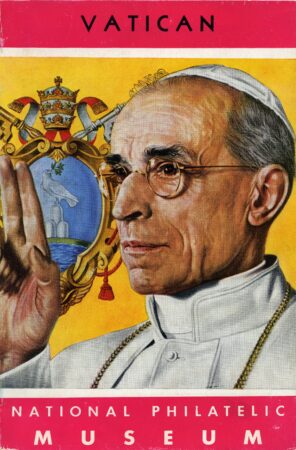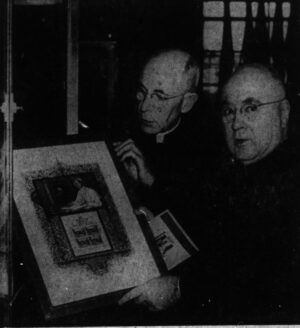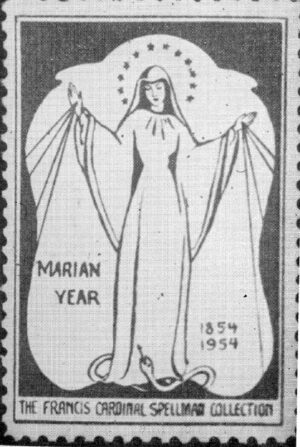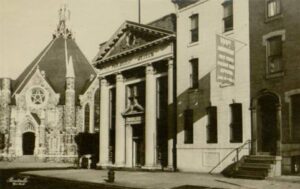
Exterior photograph of the National Philatelic Museum at Broad and Diamond Streets. In the background is the Berean Presbyterian Church.
For centuries, people have been collecting all sorts of things. Currency, Hummel figurines, trading cards... there a collection for it. Some collectors want the world to see their collection and educate the public, so they find ways to display the collection. During the 1954 Marian Year, one such exhibition took place to show one of the most popular mediums of collecting: stamp collecting. For six weeks in the Autumn of 1954 (September 22nd to November 5th), the Vatican - Marian Year Philatelic Exhibition was held at the National Philatelic Museum. Philately is the study of postage stamps and postage history. The National Philatelic Museum opened in 1948 and was located the the southeast corner of Broad and Diamond Streets. The exhibition, planned for two years, was the first of its kind ever presented and represented the finest and largest display of Vatican stamps ever shown in one place at one time. According to stamp expert and museum president Bernard Davis, the exhibit will be "unparalleled In significance and In rarity by any stamp exhibit shown thus far" in the Philadelphia museum. In addition to being the first time Vatican stamps were exhibited in America, the exhibit commemorated the 25th anniversary of the first postage stamps issued by Vatican City in 1929.

One of the first stamps issued by the Vatican Post Office in 1929. The image is that of Pope Pius X.
The largest part was the collection formed by Francis Cardinal Spellman, sixth Archbishop of New York. Even before the exhibit took place. It was a well-known fact His Eminence was an avid stamp collector. In presenting Cardinal Spellman at the opening, Archbishop O’Hara described His Eminence as “a great American citizen and a representative of the Holy Father, outstanding in the devotion he gives to God and Country." His collection consists of every Vatican stamp since 1929, which is when Vatican City was established as an independent state through the Lateran Treaty. There is also a sizeable collection of American-issued stamps, some of which depict the nation's natural wonders. One of the focal points of this collection is the framed full-sheet of "In God We Trust" stamps. This common motto, having been minted on coins since 1864, had only appeared once on a stamp commemorating the Valley Forge encampment in 1928. Cardinal Spellman wrote to president Dwight Eisenhower for the phrase to be included on a stamp. The stamp was issued in April of 1954, and the common motto would become our national motto two years later in 1956. In the program created for the exhibit, whose cover is shown at the top of the blog, Cardinal Spellman notes that:
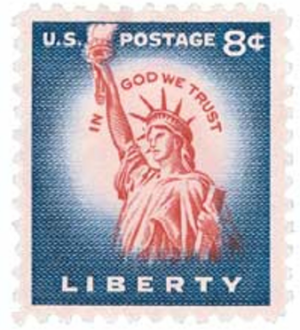
8¢ postage stamp from 1954, with the motto inscribed around the Statue of Liberty's head. At the time, eight cents was the standard rate for international postage. A 3¢ (domestic mail rate) stamp with a similar design was also issued.
Stamps are miniature documents of human history. They are a means by which a country gives sensible expression to its hopes and its needs, its beliefs and ideals. They mirror the past and presage the future. They delineate cultural attainments, industrial works, domestic, civil and social life. In a word, these vignettes give a vivid picture of the world, its occupants and their multifarious endeavors.
Along with stamps, the Spellman collection also includes rare coins and meals from both the United States and the Vatican. The collection would once again be exhibited in Philadelphia during Vistarama, the largest exhibit of Catholic Missions in United States history, in 1956. The collection, as well as the holdings of the National Philatelic Museum, are permanently housed of the campus of Regis College in Weston, Massachusetts.
The second part of the exhibit consisted of stamps issued by the Papal States between 1852 and 1870, as well as smaller exhibits loaned by prominent collectors. The Papal States were a collection of territories in central Italy that were directly governed by the Pope, essentially acting as a separate state under the Catholic Church's rule, from around 756 until 1870 when they were incorporated into the Kingdom of Italy.


